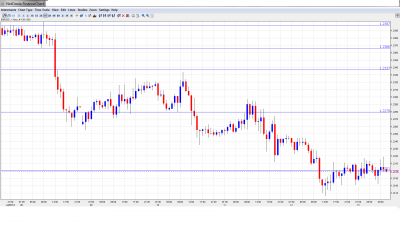EUR/USD continues to weaken following the release of Chinese GDP. Although the reading of 7.6% was close to the market forecast, the numbers were the lowest in over three years, raising fears of an economic slowdown in China. Further bad news for the euro was the decision by Moody’s to lower Italy’s credit rating. Today’s key releases include Italy’s 10 year bond auction, US PPI, and US Consumer Sentiment.
Here’s an update on technicals, fundamentals and what’s going on in the markets.
EUR/USD Technicals
- Asian session: Euro/dollar was marked by quiet trading, reaching a high of 1.2210 before edging downwards. In the European session, the pair is choppy, and continues to test the 1.22 line.
- Current range: 1.22 to 1.2288.
- Further levels in both directions:
- Below: 1.22, 1.2150, 1.20 and 1.1876.
- Above: 1.2280, 1.2330, 1.2360, 1.24, 1.2440, 1.2520 and 1.2624.
- 1.2330 is the next serious line of resistance.
- 1.22 is only a minor line before the clear historic separator of 1.2150.
Euro/Dollar steady after weak Chinese data – click on the graph to enlarge.
EUR/USD Fundamentals
- Tentative: Italian 10-y Bond Auction.
- 12:30 US PPI. Exp. -0.5%.
- 12:30 US Core PPI. Exp. +0.3%.
- 13:55 US Preliminary UoM Consumer Sentiment. Exp. 73.5 points.
- 13:55 US Preliminary UoM Inflation Expectations.
- 19:40 FOMC Member Dennis Lockhart Speaks.
For more events and lines, see the Euro to dollar forecast
EUR/USD Sentiment
- China GDP slumps: Chinese GDP climbed up 7.6%, a bit lower than the market forecast of 7.7%. Although this figure is huge compared to the growth numbers in Western countries, the reading underscores a worrying trend. It is the ninth consecutive drop in China’s GDP, dating back to July 2010. However, traders should always treat this indicator with caution, as there are numerous reasons to be skeptical about the accuracy of these releases. The fact that the China may be manipulating its key economic releases may only exacerbate market fears of a slowdown in the world’s number 2 economy.
- Italy’s credit rating drops: There was more bad news for Italy’s slumping economy, as Moody’s lowered Italy’s credit rating by two notches to near-junk status on Thursday. The rating agency cited Italy’s higher borrowing costs, weak growth, and the risk of contagion from Greece and Spain. Investors shrugged off the bad news, as at a 3-year bond auction, the treasury sold EUR 3.5 billion and the yield dropped to 4.65%. The markets will be hoping for similar good news at today’s 10 year bond auction.
- Federal Reserve continues to stand pat: The markets were disappointed by the lack of action at the Fed’s June monetary policy meeting. The Fed repeated and restated that that it would consider taking monetary measures to stimulate the US economy, but only if conditions deteriorated. The markets had hoped to see more aggressive action from the Fed to prop up the sluggish US economy. Bottom line? QE3 looks very, very unlikely, although the Fed has left the door open for action, if needed. For the time being, Operation Twist is as far as the Fed is willing to go, unless things get worse.
- Little Progress at Eurogroup meeting: At this week’s Eurogroup meeting, finance ministers was supposed to take concrete steps towards implementing the decisions agreed to at the EU Summit. However, no agreement was reached on a crucial issue – the use of rescue funds to intervene in bond markets and lower Spain and Italy’s borrowing costs,which are threatening to spiral out of control. The finance ministers did agreed to extend Spain’s deadline to reach budget targets to 2014, and stated that EUR 30 billion in aid would be made available to Spanish banks by the end of July.
- Spain announces tough austerity program: The Spanish economy is in bad shape, with an ailing bank sector, declining growth and a staggering unemployment rate of over 24%. Under strong pressure from the EU, the government announced a EUR 65 billion austerity plan, which includes a sales tax hike and slashing government expenditures including unemployment benefits.The announcement has already drawn sharp criticism in Spain, and many analysts feel that these measures will only prolong Spain’s recession.
- ESM faces legal hurdle: The European Stability Mechanism, which is the Euro-zone’s rescue fund, was supposed to come into effect on July 1. However, the German Constitutional Court has delayed its decision on whether the ESM complies with German law.ESM cannot go ahead without German support, so for now, the ball is in the hands of the court.
- Euro/dollar struggles at two-year lows: Last week, the European Central Bank cut its benchmark lending rate to a new historic low of 0.75% and also eliminated the deposit rate from the previous 0.25%. The move came after more QE from the UK and a rate cut from China. The impact on the euro from these moves by central banks was quite negative: the euro dropped sharply and the currency is now trading close to two-year lows against the US dollar. Draghi added fuel to the fire by saying that downside risks have materialized. He called the ESF unusable and stated that ESM is the preferred mechanism for relief funds.

